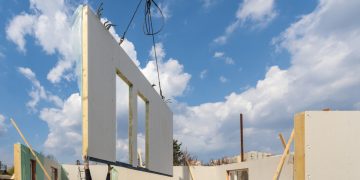Jack Conway, VP at Gil-Bar Health and Life Science
Though the government has found ways to stimulate the economy in the wake of COVID-19, industries are continuing to experience inevitable pitfalls. This is especially true of the real estate industry, where construction leaders are actively seeking methods of streamlining operations to meet new demand. One particularly pressing area in this regard is the need for sufficient healthcare facilities against the backdrop of the fluctuating pandemic.
Though the government has found ways to stimulate the economy in the wake of COVID-19, industries are continuing to experience inevitable pitfalls. This is especially true of the real estate industry, where construction leaders are actively seeking methods of streamlining operations to meet new demand. One particularly pressing area in this regard is the need for sufficient healthcare facilities against the backdrop of the fluctuating pandemic.
Modular construction systems offer a solution to this challenge. While this process has been used in healthcare markets for decades, prefabrication and modular building systems are gaining traction in the wake of unpredictable circumstances, enabling adaptable, cost-effective, safe, sustainable, and efficient processes.
In simple terms, modular construction is the process by which a building is constructed off-site to be later assembled on-site. Though the process is completed in off-site factories in a controlled setting, the prefabricated method follows the same building codes and standards as conventional construction methods. Modular construction is used in tandem with digital tools, and as technology continues to evolve, more construction leaders are seeing the potential benefits of this method.
While the process is also used for commercial, multi-family, single-family, retail, and workforce housing, the construction industry has recognized and embraced the particular necessity for healthcare facilities and the urgency surrounding their construction. Off-site construction can offer this efficiency, as sites and buildings are constructed simultaneously. In addition, with the implementation of prefabrication systems, 30-60% of the project’s overall timeline can be saved.
Among modular construction’s benefits are the significant financial savings it can offer as it lowers labor costs, reduces loan interest, and lowers risk insurance coverage. In some cases, these factors can result in up to 15% reductions in general conditions costs. Furthermore, there is a general avoidance of potential expenditures and emergency situations due to the smaller number of workers that a controlled, weather-protected, and predictable environment that an off-site facility provides.
In addition to being cost-effective, modular construction is often safer and environmentally friendly. In an immediate sense, fewer workers in the off-site factories dramatically reduces the risk of COVID-19 transmission, allowing workers to operate more efficiently. Furthermore, dangerous circumstances that have historically been leading causes of worker injury are eliminated when workers can operate in a controlled factory setting and exercise prefabricated methods. Also, because smaller modules are constructed at off-site locations and later brought on in different scheduling periods, opportunities for theft and vandalism are significantly diminished.
Regarding sustainability, considerably less material waste is produced when contractors adopt prefabrication models. The method allows contractors to keenly manage inventory and exercise greater control over project conditions. As modular construction becomes more widely practiced, factories have begun maximizing their recycling efforts, making the off-site processes safer and cleaner while also contributing to a greener earth. Some studies suggest that modular construction reduces waste by 15%, equating to approximately 24 million tons of waste annually. To provide greater context, the US reports around 160 million tons of construction waste produced every year.
Despite these numerous benefits to adopting modular construction, there are certain nuances of which construction leaders should be aware. Additionally, because the method is still gaining traction and is unfamiliar to some, the risk of poor project management remains high due to common misunderstandings surrounding how modular construction is implemented into a project schedule.
Suboptimal scheduling of staging modules in particular can result in significant disruptions in the construction process. Often, there can be an unbalanced relationship between the completion of modules on-site vs. off-site, resulting in delays, extra costs, general confusion, and series of other inefficiencies. This is especially true due to the smaller number of hands-on workers in the factory to catch mistakes or rectify them. Construction leaders can avoid these pitfalls by implementing a professional risk management plan and hiring a comprehensive project management team to establish standards and guidelines before launching the development. This will alleviate delays, reduce risk, and lessen unwanted operating costs.
As the modular method rapidly gains popularity and the healthcare industry is seeing increasing infrastructure investments, contractors should understand the benefits of prefabrication techniques to the best of their ability. Should the method continue to be properly implemented, however, the healthcare industry will continue to see its needs met in a more efficient and expeditious fashion, empowering it to address these unprecedented times.
Construct America Magazine | The Home of Construction Industry News




















